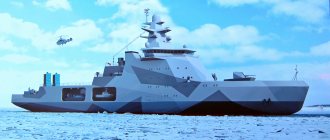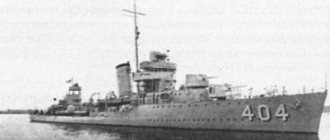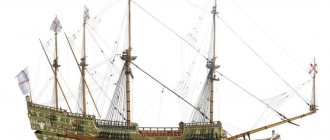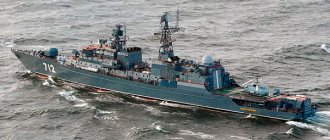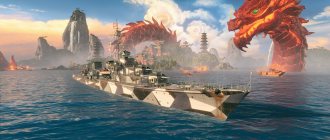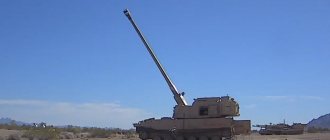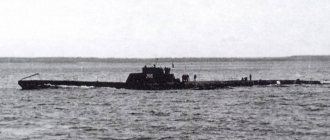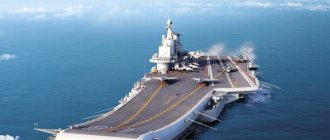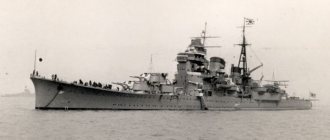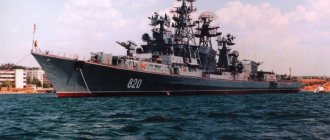Evolution
When designing the new ship, they took the relatively small (three ships) Yorktown series as a basis.
The total displacement increased by almost 10 thousand tons, but the designers did not produce anything revolutionary - it was necessary to make an effective aircraft carrier that was convenient to operate, and not a combination solution to all problems at once. The additional mass was used to increase aviation fuel reserves, the size of the take-off deck, strengthening the armor and armament, as well as a more spacious hangar. They did not (although they were thinking about) heavily armoring the deck, like the British, as this would have reduced the size of the air group. The most radical change was the single side aircraft lift behind the deck contour. This increased the launch speed of aircraft and the size of the hangar, and also made it possible to use aircraft whose dimensions exceeded the outline of the elevators.
Yorktown-class aircraft carrier (CV-5)
There were some fly in the ointment - the seaworthiness of the Essex, although it was quite sufficient for successful operation, but against the general background left much to be desired. The desire to reduce the number of any holes in the deck to a minimum did not go unnoticed. They wanted to increase its strength - in fact, they worsened not only ventilation, but also the possibility of evacuation in case of fire - this subsequently cost a considerable number of lives.
Like hot cakes
The creators of the Japanese blitzkrieg in the Pacific assumed that the United States, having lost convenient bases and the core of the fleet, would prefer to “not get involved” and go to peace negotiations. But Washington “contacted” by using its main trump card - the American advantage in industrial power. Its most striking expression was the Essex aircraft carriers - 24 of them were built, including 17 during the war.
The first Essex (CV-9) was ready in December 1942 - after a year and a half of construction and a year after America entered the war. After that, until the very end, the US Second World Fleet received an Essex every 1.8 months - an amazing rate of construction!
Essex-class aircraft carrier (CV-9)
Origins of the Essex-class aircraft carriers
Origins of the Essex-class aircraft carriers
The Essex-class aircraft carriers are descended from two ships with a total displacement of 40,000 tons, the construction of which was provided for by the Naval Expansion Act of 1938 (the Vinson-Trammel Act). The first ship, the Hornet (CV-8), was laid down in Marya in 1939 and launched in September 1939. Due to the urgent need for aircraft carriers, the Hornet was built according to the Yorktown design, whose displacement was 19,000 t. The development of a new project would delay the start of construction of the ship by 15 months. Changes made to the Hornet's design compared to the Yorktown were limited to replacing the Mk. 33 for the Mk system. 37 and a reduction in the size of the island in order to compensate for the increased mass; in addition, the width of the flight deck in the fore part was slightly increased.
But the Essex (CV-9) was a ship of a new project, specifically designed for operations against the Japanese Navy in the Pacific Ocean. The CV-9 aircraft carrier took the entire 20,400-ton displacement reserve set for the Yorktown and Enterprise ships, confirming that compared to the 14,700-ton Wasp, large aircraft carriers are more responsive to the cost-effectiveness criterion. At the same time, the CV-9 project was a development of the Yorktown, although it took into account the operating experience of ships of earlier construction.
USS LANGLEY (CV-1)
USS LEXINGTON (CV-2)
USS RANGER (CV-4)
USS YORKTOWN (CV-5)
USS WASP (CV-7)
USS ESSEX (CV-9)
The new ship was supposed to be faster, with better survivability and improved armor protection, and also had to accept a larger number of aircraft, and the size of the aircraft increased. The experience of operating aircraft carriers revealed the urgent need to include a fifth fighter squadron in the naval air group, in addition to squadrons of torpedo bombers, bombers, reconnaissance aircraft and fighters, that is, the air group had to have two fighter squadrons. However, the composition of the air group was limited by the size of the flight deck due to the concept adopted in the US Navy of equipping aircraft directly on the deck. In other words, the deck had to accommodate all the aircraft of the air group and still have free space for the first airplanes to take off. The designers decided to increase the size of the deck by reducing the size of the above-deck structures. The 5-inch caliber guns on the starboard gallery, installed on the Yorktown, were replaced on the Essex with two-level turrets installed in the side cutouts. The dimensions of the island superstructure were minimized; the aircraft lift was placed, like on the Wasp, at the end of the deck, and not in its middle.
The aircraft carrier CV-20 Pennington at the outfitting wall of the shipyard in Brooklyn, New York City, March 9, 1944. At the top of the photo is the battleship BB-63 Missouri.
The aircraft carrier CV-16 Lexington in the waters of the port of Boston. The photo was taken on the day the ships entered service with the US Navy, February 17, 1943. Snow and ice cover the flight deck, nothing—hot days ahead for the aircraft carrier.
Essex-class aircraft carriers
| serial number | Name | went into operation |
| CV-9 | "Essex" | December 31, 1942 |
| CV-10 | "Yorktown" | April 15, 1943 |
| CV-11 | "Intrepid" | August 16, 1943 |
| CV-12 | "Hornet" | November 29, 1943 |
| CV-13 | "Franklin" | January 31, 1944 |
| CV-14 | "Tikondiroga" | May 8, 1944 |
| CV-15 | "Randolph" | October 9, 1944 |
| CV-16 | "Lexington" | February 17, 1943 |
| CV–I7 | "Bunker Hill" | May 24, 1943 |
| CV-18 | "Wasp" | November 24, 1943 |
| CV-19 | "Hankook" | April 15, 1944 |
| CV-20 | "Bennington" | August 6, 1944 |
| CV-21 | "Boxer" | April 16, 1945 |
| CV-31 | "Bonhomme Richard" | November 26, 1944 |
| CV-32 | "Pour" | April 11, 1946 |
| CV-33′ | "Kearsarge" | March 2, 1946 |
| CV-34 | "Oriskany" | September 25, 1950 |
| CV-35 | "Reprisal" | order canceled 15 August 1945 |
| CV-36 | "Antitem" | January 28, 1945 |
| CV-37 | "Princeton" | November 18, 1945 |
| CV-38 | "Shangri La" | September 15, 1944 |
| CV-39 | "Lake Champlain" | June 3, 1945 |
| CV-40 | "Tarawa" | December 8, 1945 |
| CV-45 | "Valley Forge" | November 3, 1946 |
| CV-47 | "Iwo Jima" | order canceled 15 August 1945 |
| CV-47 | "Philippine Sea" | May 11, 1946 |
| CV-50 - CV-55 | orders canceled March 27, 1945 |
Aircraft carrier CV-10 "Yorktown", loading either on board aircraft from the ship or the theater of operations, May 1943. F6F "Hellcat" fighters are painted in a new three-color scheme, but retain large identification marks of the 1942 model. Antennas along the edge of the flight deck installed vertically. The aircraft lift is lowered into the hangar.
By the time design of the Essex began in early 1939, the Yorktown aircraft carrier had only been in service for a year. Also, the designers had no idea how the military’s views on the methods of combat use of aircraft carriers would change. For example, the military continued to insist on the ship's ability to develop high speed in reverse, supposedly necessary to rescue a splashed-down aircraft, or on the ship's ability to conduct artillery combat using only 8-inch caliber guns. The military demanded that the aircraft carrier have armor that could protect the ship from artillery fire from cruisers, armor similar to that of the aircraft carriers Lexington and Saratoga.
The aircraft carrier CV-13 Franklin steams on the Elizabeth River, February 21, 1944. The ship recently entered service with the US Navy. The aircraft carrier is painted according to scheme 32/6A, the deck is blue No. 21.
Short body
Extended body
The Essexes received better armor than their predecessors. The number of 5-inch caliber guns was increased to 12 barrels. while the Yorktown carried eight five-inch guns. The anti-aircraft weapons were completely updated by installing new 40-mm and 20-mm Oerlikon anti-aircraft guns.
Passive defense is represented by an armored hangar and an armored belt along the waterline. The armored deck had to be abandoned. since it significantly increased the mass of the ship and worsened its stability. Interest in the armored deck was aroused by the British experience of using aircraft carriers in the Mediterranean, where they were often bombed by enemy aircraft. The decisive factor in the Americans’ refusal to have an armored deck were considerations that were not at all constructive: due to the American practice of equipping aircraft directly on the deck, and not in the hangar, it was dangerous for a bomb to “merely” hit the deck. To cause a major fire on a British aircraft carrier, a bomb needed to penetrate the deck and enter the hangar. To “organize” a fire on an American-built aircraft carrier, the bomb only needed to explode among the aircraft positioned on the deck with ammunition laid out around them.
USS CV-20 Bennington, December 13, 1944. Deck Blue is randomly spotted on the deck. Compare the lighter camouflage of the Bennington compared to the dark camouflage of the Franklin. The darkest camouflage color on the sides of the Bennington is Deck Blue, and the darkest color of the camouflage on the Franklin is Dull Black.
On the Essex, armor covered the boiler room and auxiliary power unit, which had a positive effect on the survivability of the ship. Such an auxiliary power unit was available on the Wasp, but not on the Hornet. It was the absence of such an installation, according to official historians of the US Navy, that caused the death of the Hornet in October 1942 in the Santa Cruz Strait, when the aircraft carrier, which had lost its speed, became a victim of Japanese destroyers. Perhaps the main disadvantage of the Essexes was the poor ventilation system. In order to provide better protection, a minimum number of holes were made in the ship's armored hangar; as a result, even in the event of a small fire, the hangar quickly filled with smoke and gas, which greatly complicated the fight against the fire. The fire sometimes took on catastrophic proportions, as happened on the Franklin. The combat training room and crew quarters on the Essex were poorly located - immediately below the flight deck, which made them vulnerable to any shelling. These ship defects were partially eliminated during post-war repairs and modernizations.
The price for all changes in the ship's design was a rapid increase in displacement from the original 20,400 tons to 23,000 tons - the upper limit of the displacement of an aircraft carrier, established by the London Naval Agreement of 1936. Ultimately, the Essex's standard displacement was 27,000 tons, and the total - 33,000. After the war, during repairs and modernization, the ship’s total displacement increased to 44,700 tons.
USS Essex-1943
Anti-aircraft weapons, 1943–1945
The aircraft carrier CV-19 "Hankook", the antennas at the edge of the flight deck are installed in a vertical position. Note the “clipper” stem and shortened flight deck of the “long-hulled” Essex. The lengthening of the hull, coupled with a shorter flight deck, made it possible to place a 40-mm anti-aircraft gun in the bow.
Already in 1940, the Navy realized the need to build a series of aircraft carriers, rather than just one ship. By law in May 1940, Congress approved the construction of 10–12 ships CV-I0 - CV-12 for the so-called “fleet of two oceans”; already in the summer of 1940, after the fall of France, the construction of ships CV-13 - CV-19 was approved. The aircraft carriers CV-20 and CV-21 were ordered just a few days after the Japanese attack on Pearl Harbor - December 15, 1941. The ships CV-31 - CV-40 were ordered in August 1942, CV-45 - CV-47 - in June 1443. Aircraft carriers CV-50 - CV-55 were supposed to be ordered in 1945... but US President Roosevelt vetoed the construction of these ships. In reality, construction began on 26 Essex-class aircraft carriers; 24 ships entered service, including one modernized ship, which was completed after the end of the war. 17 of the 24 aircraft carriers entered service before the end of World War II, 14 of them took part in combat operations.
Essex-class aircraft carriers were built at the Newport News shipyard, at the Navy shipyards in Norfolk, Philadelphia, New York, and the Bethlehem Quincy shipyard. The first ship in the series, the Essex, was laid down on April 28, 1941 at the Newport News shipyard, where the Hornet was built. The construction of aircraft carriers was given the highest priority. therefore, on average, the construction of one Essex took only 15 months.
Aircraft carrier CV-9 Essex, photograph taken immediately after the ship was launched. The nasal tip of the “short” hull is clearly visible.
The aircraft carrier CV-9 Essex heads for the theater of operations, March 20, 1943. F6F Hellcat fighters and SBD Lightless dive bombers stand on the deck. The aircraft are painted according to the 1942 scheme: the top is blue-gray, the bottom is light gray. Identification marks are large.
The aircraft carrier CV-11 Intrepid resupplies at Hunters Point, June 1944. The Intrepid is a short-hulled Essex with one quadruple 40mm anti-aircraft gun installed in the bow.
The aircraft carrier CV-19 "Hankuk" at the outfitting wall of the naval shipyard in Boston.
Simple Richard's favorite aircraft carrier
The world does not know many cases when different ships in the same fleet in the same period of time were named after the same person. A funny curiosity came up with the Essexes - not only were two ships named after one person at the same time, but also two ships of the same series.
These were the aircraft carriers CV-13 and CV-31 - Franklin and Bon Homme Richard. If everything is clear with the first, then the name of the second reproduced one of Benjamin Franklin’s pseudonyms - Simpleton Richard. Thus, if Franklin himself could name his favorite two ships of the Second World War, he could rightfully designate these two Essexes as such.
Technically, of course, CV-31 was not literally named in honor of Franklin, but in memory of the famous sailing ship "Bonn Homme Richard" from the Revolutionary War, which was named precisely in honor of Franklin's pseudonym. Yes, this is exactly the frigate commanded by the famous John Paul Jones, who became an admiral in the service of Catherine the Great and fought the Turks on the Dnieper-Bug estuary.
USS Bon Homme Richard (CV-31)
Content
- 1 Power plant
- 2 Representatives
- 3 Literature
- 4 Links
Power plant[ | ]
The installation was unified with a similar installation of the light cruiser Atlanta and was, as it were, a double version of the latter: four main units and eight steam boilers instead of two and four on the cruiser. Each of the GTZ worked on its own propeller. Compared to those used on the cruiser, the aircraft carrier's boilers were distinguished by lower pressure (39.5 atm). Gear reducers were the main source of problems, and the noise during their operation reached 125 decibels.
Fighting
The Essex arrived at a good time - the Japanese blitzkrieg had already been stopped. American industry went into full gear and supplied the war not only with aircraft carriers, but also with a huge amount of excellent equipment and supplies - from the Sherman tank to wool socks. The American advantage in everything grew every month, and the Japanese's ability to inflict any adequate damage fell.
Therefore, not a single Essex, unlike many of its predecessors, was sunk in battle - although damage occurred, including the most severe.
With the surrender of Japan, the war did not end for the Essexes - Korea and Vietnam were waiting for them. Six aircraft carriers of this type took part in the first war, five in the second.
In addition to military campaigns and exercises, the Essexes were also involved in the search for space modules that had fallen into the sea - the abundance of aircraft on ships sharply increased the capabilities of visual reconnaissance.
Armament
Main armament of aircraft carriers
their aircraft were of the Essex type:
- A fighter force equipped with 36 F6F Hellcats, which were superior to the Japanese A6M Zeros.
- A formation of dive bombers equipped with an SB2C Helldiver.
- Torpedo boat group equipped with 18 TBF Avenger torpedo bombers.
The war forced them to diversify. Thus, Avengers were designed as torpedo boats, but their greater payload capacity allowed them to perform other types of missions (anti-submarine patrol, reconnaissance, attack, etc.).
From April 1944, the F6f Hellcat fighters were supplemented by the new F4U Corsair. The fighters performed assault, anti-submarine and night combat missions.
Aircraft carriers
The Essex class have secondary armament similar to most other US aircraft carriers. They had 12 5-inch (127 mm) guns with real anti-aircraft capabilities, as their anti-aircraft shells were proximity fuzed. In addition to these guns, their short-range armament consisted of quadruple 40 mm cannons, supplemented by anti-aircraft machine guns and machine guns. The largest anti-aircraft weapons needed during the war reached a weight of about 1000 tons.
Modernization
"Essex" began to be modified during the war. Not so much due to obsolescence, but because of the emergence of kamikazes - the recipe for this was a sharp increase in the number of anti-aircraft artillery and improved fire control systems.
After the war, some Essex aircraft were upgraded so that they could receive and launch jet aircraft. Their hull was enlarged and the know-how of that time was added - a corner deck, like on today's aircraft carriers.
But most unusual of all was the fate of the three Essexes, which were converted into helicopter carriers (LPH) - they carried 1,650 infantrymen, three to four dozen helicopters, infantry equipment and ammunition.
Modernization of the Essex from 1940 to 1960
Design
air operations
Like the Yorktowns
", the
Essex
had a hangar separated from the hull to avoid damage to the ship's hull in the event of an accident or collision with the enemy. The placement of the central elevator was a major design innovation, it was located on the port side of the bow, and could also be folded to the side, thus blocking access to the hangar during navigation.
The aircraft carriers had three catapults for launching devices, two in the forward part of the flight deck and one transverse in the hangar. but the latter was not very popular with the Navy, being installed only on USS Yorktown, USS Intrepid, USS Hornet, USS Bunker Hill and USS Wasp. In theory, this made it possible to launch reconnaissance instruments while the ship was parked, but in practice this was of little use and no one liked it. The catapults were H-IVc models capable of launching 7.3 tons at 74 knots. The latest units assembled the H-IVb with a lifting capacity of 8.2 tons at a speed of 78 knots.
Many years of lessons have been collected in the design of the braking elements; they were studied so that it was possible to take the aircraft both from the stern and from the bow. The island was compacted as much as possible so that the flight deck was completely clean, so as not to interfere with aircraft operations, and also allowed for increased firing range for anti-aircraft weapons.
Protection
Taking into account the lessons of the first years of the war, the protection was improved: the armor belt was 76 mm (mm) thick in the center of the hull, tapering to 50 mm at the ends. Transverse bulkheads ranging from 50 to 76 mm thick protected the vital centers of the cabin. It had three armored decks; the flight deck was 38 mm thick, the hangar was 76 mm thick and the main deck was 48 mm thick. Against torpedoes and mines there were compartments and longitudinal bulkheads along the entire length of the ship.
During the war, their weapons changed. The main guns were 4 twin 127mm dual-purpose mounts, with two turrets located in front of the island and two at the rear. In addition, 4 more simple pieces of 127 mm were placed in the external supports on the left side. The deadliest anti-aircraft weapons were the Hazemeyer quad mounts of 40/56 mm
.
By 1945, the Essex
had 17 and
the Ticonderoga
had 18, for a total of 72 40mm guns by 1945.
The anti-aircraft guns were equipped with simple Oerlikon mounts.
20 mm, distributed in groups of 52, which were increased to 70 by the end of the war. The large number of anti-aircraft weapons installed increased the weight of the ship by approximately 1000 tons.
The US Navy settled on these calibers for their anti-aircraft guns because they believed that the calibers used up to that time did not have the firepower against the modern aircraft their ships might encounter. In addition, the 127 mm guns could also be used for anti-aircraft fire.
In 1945, aircraft carriers had all the achievements of electronic warfare: 1 long-range warning radar (range 120 miles), short-range warning spacecraft, SP altimetry and fighter control, 2 ship search radars FC, state identification systems, active and passive ECM; and two Mk.4 bombardment radars.
Movement
Propulsion was provided by 8 Babcock & Wilcox boilers, which drove 4 Westinghouse turbo gearboxes, each consisting of a high pressure turbine and a two-flow low pressure turbine with built-in reverser. The low pressure turbine for cruising speed was connected to the high pressure turbine using a gear reducer. These machines proved to be reliable and very efficient, being able to travel 18,000 miles at 12 knots.
air group
The air group consisted of 80 to 90 aircraft, but in special cases up to 110 aircraft were shipped, of course, not all of them fit in the hangar. When the first ships entered service, the same aircraft models as the Yorktowns were operated.
At the beginning of 1943, new, more powerful and heavier aircraft began to enter service, which caused an increase in their displacement. At first, the air group was formed according to the standards of the US Navy: 36 fighters, 36 dive bombers and 18 torpedo bombers. But by July 1944 there were already 54 fighters, 24 dive bombers and 15 torpedo bombers. In January 1945, the official strength of the Navy was 73 fighters, 15 dive bombers and 15 torpedo bombers. The increase in fighter numbers responded both to the kamikaze threat and to allow them to serve as fighter-bombers, supporting troops on the ground or protecting the fleet as needed. [ 1 ]
Reforms after 1945
Aerial view of USS Intrepid
after conversion by SCB-27C (left) and SCB-125 (right).
After the war there were several modernization programs for the Essex class.
Not all aircraft carriers received the same treatment. [2]
- SCB-27: Reconstruction of superstructure, cockpit and other elements. The work took about two years. SCB-27A: New catapults, new island, suppression cannon, new bow.
- SCB-27C: Same as A, but with different catapults and rear elevator moved to the side.
- SCB-125: between 1954 and 1959. Tilt flight deck and other improvements for airworthiness and air operations.
- SCB-144: Anti-submarine capabilities were improved in 1965 (SQS-23 hull and new combat control center). [3]
Three Essex-class aircraft carriers have been converted to helicopter carriers after the Navy abandoned escort carriers due to their age and inadequate size. USS Boxer
(LPH-4), USS
Valley Forge
(LPH-8), and USS
Princeton
(LPH-5) served as Marine helicopter carriers.
